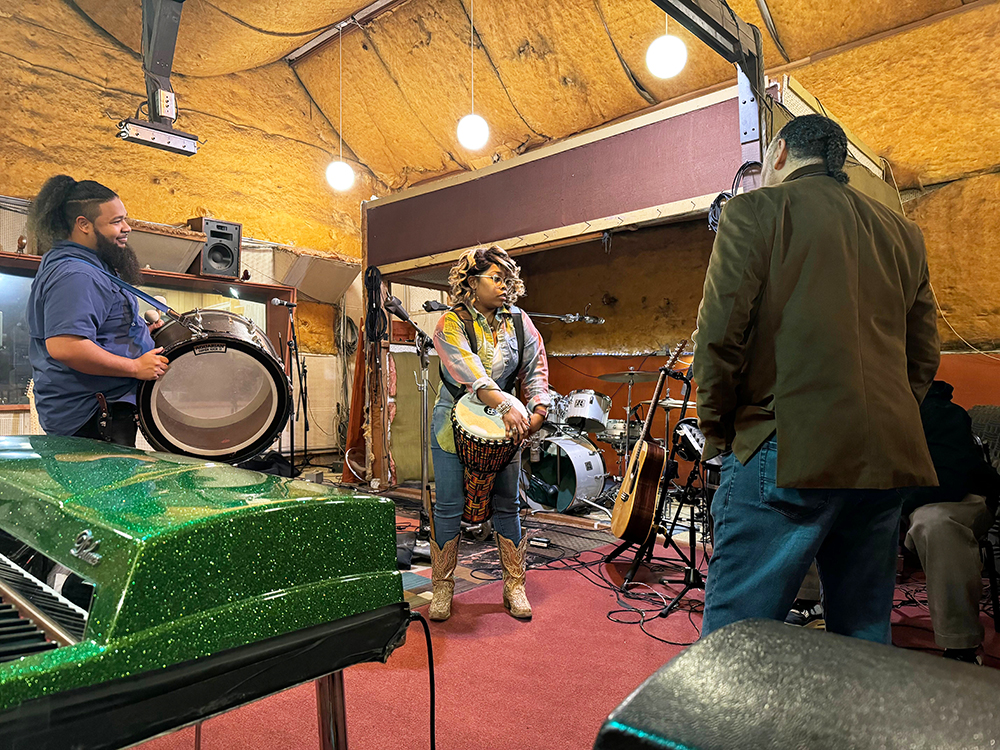You know music will be at the heart of a movie when both its writer/director and composer are researching its soundtrack over a year before its release, making an epic road trip that’s equal parts fact-finding, soul-searching, and club-hopping. Such was the case for this summer’s popular and critical smash hit Sinners, a film that weaves the blues deep into its narrative threads of vampirism, spiritualism, and racial identity. Indeed, music plays such a central role in the film that its box office success has gone hand in hand with the soundtrack’s fortunes, the album having risen to the top of Billboard’s blues charts, to number five in the soundtrack charts, and to number 18 in the Americana charts within two weeks of its release. And it’s worth noting that the musical pilgrimage that informed the film so deeply was launched here in Memphis, with Royal Studios’ Boo Mitchell at the helm.
“The Mississippi Delta begins in the lobby of the Peabody Hotel,” runs the old quote, and that was certainly the case when Mitchell and Hi Rhythm guitarist Lina Beach pulled up to that fabled lobby with a van and driver; picked up Sinners’ writer/director Ryan Coogler, composer Ludwig Göransson, and his father, Tomas Göransson; and headed to Clarksdale, Mississippi.
“As soon as we get to Clarksdale and turn off the highway, right where you go past that grove of beautiful pecan trees, Ryan was, like, ‘Pull over, man!’” says Mitchell. “So he starts taking pictures and video. I didn’t know what they were up to. I knew who they were, definitely, so I thought, ‘Maybe they’re scouting a movie or something.’ And we get into Clarksdale, and there was a festival, and Super Chikan was playing!”

Seeing one of the Delta’s most original artists, a purveyor of the living blues as it exists today, was the perfect introduction to the contemporary scene, and perfect for Mitchell’s guests, all avowed fans of the blues. “Ludwig’s father has had a blues band for 35 years in Sweden, and they play all this Albert King stuff. So they got to see Super Chikan, and that was mind-blowing. He’s up there playing the diddley bow and all that stuff.”
That was just the beginning. Moving on to Morgan Freeman’s Ground Zero Blues Club, also in Clarksdale, they saw Anthony “Big A” Sherrod & the All Stars, and from there went on to a hotel in Cleveland, Mississippi, checking in on the Grammy Museum there. “The next day we get up and drive to Indianola, and it’s just a whole lot of cool topography. Ryan had us pulling over in spots where there was some kind of river or stream or something, and he’d start taking pictures of the scenery.”
But it was Indianola’s B.B. King Museum that was the real draw, where the museum director first gave them a personal tour, then asked, “Y’all want to go see Club Ebony? We just redid it.” That drew an immediate yes. “We were like, ‘Club Ebony, where B.B. King cut his teeth as a performer? Hell yeah, we want to go see it!’” explains Mitchell. “He’s like, ‘I’m gonna grab one of B.B.’s guitars.’ And the guitar that he just happened to grab was Lucille 01! So we hung out at empty Club Ebony, and it’s a really cool place because it looks almost exactly like it was back in the day. And so then [the museum director with Lucille] said, ‘Somebody want to play it?’ So Lina was immediately, like, ‘Hell, yeah.’ Then Ludwig’s father was playing it.”
Beyond that, the traveling party was learning some history. “I was telling them about sharecroppers, plantations, and the plantation bucks,” recalls Mitchell. “I’m like, ‘This the first form of economic slavery and how they kept the slaves on the plantation. That money was only good at the plantation store, right?’ And Ryan was fascinated by that. I think he had some knowledge of it. But he liked hearing another account, and then I ended up taking them to the Dockery Plantation. He was trying to get his hands on some of these plantation bucks.”
Those who’ve seen the film know how company scrip comes to play a role in the story. But it was ultimately seeing and hearing the music that made the most lasting impact. The filmmaking team now had a clearer vision of how to proceed. “Ludwig asked me to put together a list of blues musicians who I thought were authentic. So, you know, I made a list, and Bobby Rush was at the top of that list. Then Alvin Youngblood Hart, Cedric Burnside, Southern Avenue, and Sharde Thomas Mallory [Otha Turner’s granddaughter and leader of the Rising Stars Fife and Drum Band]. A lot of people on that list ended up on the soundtrack.”
And much of the hit album was in turn recorded by Mitchell. While Göransson worked on most of his score in Los Angeles or New Orleans, the composer booked time at Royal for the bluesiest musical segments. “They wanted me to assemble the team,” says Mitchell. “So I called Bobby Rush, Charles Hodges, Cedric Burnside, Tierinii Jackson,” and others. “They were interested in writing new songs. So people were pairing off, like Cedric and Tierinii wrote a song. Reverend Hodges and Super Chikan wrote some stuff. We did all these crazy pairings and people would go home, write some more, and come back. So it’s like a big writing session. And out of that, Alvin Youngblood Hart wrote ‘Travelin’.’”
The song is pivotal in the film, seeming at once timeless and fresh, and establishes the character Sammie Moore’s command of the blues. As it turned out, the actor playing the bluesman internalized Hart’s composition. “Alvin didn’t perform,” says Mitchell. “Miles [Caton] learned the song and played it. But I was really glad to see Alvin was in the mix. Because he’s like the modern personification of a 1930s Delta bluesman. Like, that’s who he is.”
